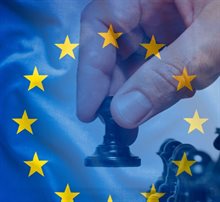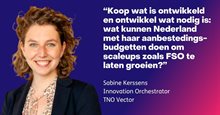Working towards a vibrant and less vulnerable economy
The Covid pandemic and the war in Ukraine, in particular, revived the debate on strategic autonomy. We could no longer take completely for granted that trading partners would supply us with the necessary raw materials, products, and semi-finished goods at acceptable costs.
One example of this is technology and our digital autonomy. For cloud computing – and specifically the big cloud platforms – we in the EU rely heavily on non-European companies. It is in the interests of politics and governance, as well as the business world, that we again make strategic and digital autonomy a policy priority.
We therefore need policies both in the EU and the Netherlands that make us less dependent on a limited number of foreign suppliers. That would lower the risk of others setting the rules. And prevent supply chain gridlock in the event of major geopolitical or international events. The goal is a vibrant and less vulnerable economy.
The pandemic and war
The current situation is therefore undesirable. But what does it take to become sufficiently autonomous? We experienced during the pandemic the risks of not having our own production facilities for facemasks and other medical materials.
Due to the war in Ukraine, we are experiencing the consequences of an interrupted gas supply. These events exposed our vulnerabilities. What is the state of strategic autonomy as regards other products, technologies, and activities?
Is strategic autonomy measurable?
The debate on strategic autonomy is wide-ranging. From gas to rare earths, from high-tech to data and even technology that is not yet mature, such as quantum computing or artificial intelligence. How do we measure this? What should we look at if we want to make strategic autonomy measurable?
TNO has been studying the concept of strategic autonomy and ways to implement and monitor it for a number of years. Specialists Claire Stolwijk and Ton Bastein explain: ‘Much more insight is needed, into the risks of unilateral dependencies, for example. And there’s a need for indicators to identify the risks we face. That’s the basis for our recommendations.
Politicians are pointing to the urgency of this problem and proactive policies are needed to ensure we don’t lag behind in developments. If we want to increase our strategic autonomy, we need to know what solutions are available in the technological field, or through political or business policy.’
Digital autonomy
As an example, Stolwijk mentions digital autonomy. ‘More than 90% of the Western world’s data is stored on US servers. Most of our own digital infrastructure comes from a small number of non-European parties.
No European company is in the global top 20 of big tech. What does this mean for our future earning power and our ability to innovate, and what can we do about it? Conducting research in various disciplines at the same time – economics, technology, political science, etc. – enables us to advise policymakers. There’s often no one-size-fits-all solution to a complex and dynamic issue such as digital autonomy.’
Ton Bastein, who at TNO Vector mainly does research on critical materials and circularity, says: ‘Think of our research as the basis for a risk analysis. A kind of insurance premium in an unpredictable world. Access to raw materials and semi-finished products for our industry and society is a serious concern. We can only tackle this if government agencies and the market work together on knowledge about supply chains and potential problems arising within them.’





